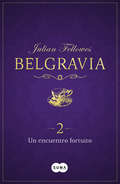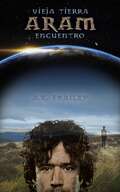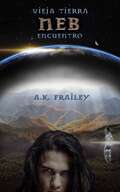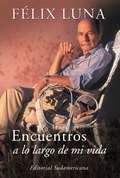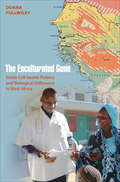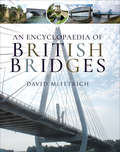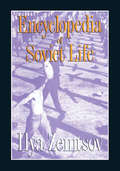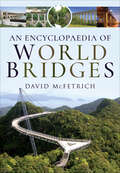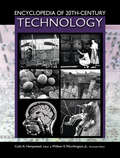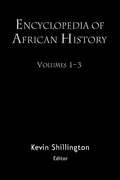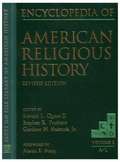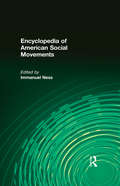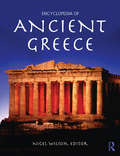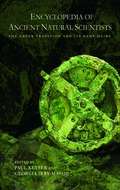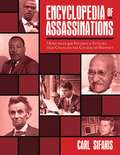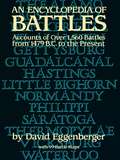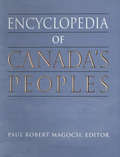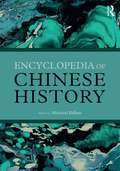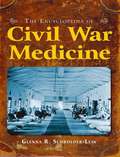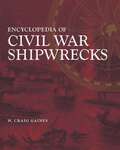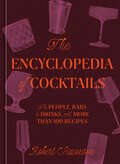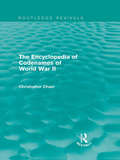- Table View
- List View
Un encuentro fortuito (Belgravia #2)
by Julian FellowesBelgravia, del creador de Downton Abbey, Julian Fellowes, es una historia publicada en 11 capítulos en la mejor tradición de las novelas por entregas. En este segundo capítulo, una invitación a tomar el té acaba provocando unas sorprendentes revelaciones. Muy cerca de Buckingham Palace, tras las puertas de las grandes mansiones del Londres victoriano reinan el escándalo y la intriga. Bienvenidos a Belgravia. Ambientada a mediados del siglo XIX, en una sociedad victoriana en la que los nuevos ricos de la industria y el comercio comienzan a codearse con la más arraigada aristocracia, Belgravia está poblada por un rico reparto de fascinantes personajes. Esta es la historia de un secreto. Un secreto que se oculta al otro lado de las elegantes puertas del barrio más exclusivo de Londres. Su historia será desvelada en capítulos sucesivos llenos de giros, revelaciones y finales inesperados. La crítica ha dicho...«Una trama repleta de sorpresas, diálogos frescos y una ambientación fascinante».The New York Times
Encuentro Vieja Tierra ARAM (Vieja Tierra Aram Encuentro Libro Uno, Vieja Tierra Ishtar Encuentro Libro Dos, Vieja Tierra Neb Enc #1)
by A. K. FraileyAram debe llevar a su clan a un lugar seguro, proteger a un hombre inocente, perdonar a su descarriada esposa y desafiar una maldición que acecha su alma. A medida que Aram se encuentra con el bien y el mal, un mundo alienígena observa y espera que su parte juegue en la futura esperanza o desesperación de la humanidad.
Encuentro Vieja Tierra Neb (Encuentro Vieja Tierra Aram Libro Uno, Encuentro Vieja Tierra Ishtar Libro Dos, Encuentro Vieja Tier #1)
by A. K. FraileyCriado en un mundo de bestias salvajes, espíritus cobardes y almas nobles, Nab domina a todos a su alrededor. Su madre alimenta sus mentiras, su padre cae ante él y sus hermanos huyen. Solo en el amor encuentra una fuerza a la que no puede resistir. Su esposa tiene dos hijos que toman caminos opuestos. La maldición de Neb sigue a ambos. El cielo y el infierno esperan su respuesta. A través de los ojos de tres mundos alienígenas, también lo hace el universo de observación.
Encuentros
by Felix LunaEste es un libro diferente de los que conforman la vasta obra de FélixLuna. Escrito en tono casi intimista, es un testimonio excepcional y unarevisión de sus encuentros con la historia y la música, la política y laliteratura, el país y su gente, a veces tierno, a veces emotivo, a vecesrisueño. Sin proponérselo, nos conduce a una especie de memoria central deeste siglo en la Argentina, por medio de un relato fluido que no ofreceuna acumulación de anécdotas sino un itinerario veraz y apasionado.«Encuentros» es una forma distinta del dialogo que Félix Luna vienemanteniendo hace años con el público argentino. Quienes lo inicien o loreanuden, comprobaran y confirmaran su percepción de la realidadnacional y su sensibilidad para interpretarla, esta vez en clavepersonal; no histórica. Un gran libro que sale al encuentro de suslectores.
ENCUENTROS (EBOOK)
by Felix LunaEste es un libro diferente de los que conforman la vasta obra de Félix Luna. Escrito en tono casi intimista, es un testimonio excepcional y una revisión de sus encuentros con la historia y la música, la política y la literatura, el país y su gente, a veces tierno, a veces emotivo, a veces risueño. Así sin proponérselo, nos conduce a una especie de memoria central de este siglo en la Argentina, por medio de un relato fluido que no ofrece una acumulación de anécdotas sino un itinerario veraz y apasionado. Encuentros es una forma distinta del dialogo que Félix Luna viene manteniendo hace años con el publico argentino. Quienes lo inicien o lo reanuden, comprobaran y confirmaran su percepción de la realidad nacional y su sensibilidad para interpretarla, esta vez en clave personal; no histórica. Un gran libro que sale al encuentro de sus lectores.
The Enculturated Gene
by Duana FullwileyIn the 1980s, a research team led by Parisian scientists identified several unique DNA sequences, or haplotypes, linked to sickle cell anemia in African populations. After casual observations of how patients managed this painful blood disorder, the researchers in question postulated that the Senegalese type was less severe. The Enculturated Gene traces how this genetic discourse has blotted from view the roles that Senegalese patients and doctors have played in making sickle cell "mild" in a social setting where public health priorities and economic austerity programs have forced people to improvise informal strategies of care. Duana Fullwiley shows how geneticists, who were fixated on population differences, never investigated the various modalities of self-care that people developed in this context of biomedical scarcity, and how local doctors, confronted with dire cuts in Senegal's health sector, wittingly accepted the genetic prognosis of better-than-expected health outcomes. Unlike most genetic determinisms that highlight the absoluteness of disease, DNA haplotypes for sickle cell in Senegal did the opposite. As Fullwiley demonstrates, they allowed the condition to remain officially invisible, never to materialize as a health priority. At the same time, scientists' attribution of a less severe form of Senegalese sickle cell to isolated DNA sequences closed off other explanations of this population's measured biological success. The Enculturated Gene reveals how the notion of an advantageous form of sickle cell in this part of West Africa has defined--and obscured--the nature of this illness in Senegal today.
An Encyclopaedia of British Bridges
by David McFetrich&“An already impressive reference work has been made significantly more valuable . . . a well-illustrated alphabetized compendium of notable bridges.&” —The Happy Pontist Bridges have a universal appeal as examples of man&’s mastery of nature, from picturesque packhorse bridges to great spans stretching across broad estuaries, and the development of the technology that allows ever more audacious constructions is never-ending. Of the million or more bridges throughout Great Britain, David McFetrich has selected those that are significant in terms of their design, construction or location, or of their connections with people or events of history. His definitive book contains 1,600 separate entries for individual bridge sites or related groups of bridges covering more than 2,000 different structures, 165 general entries about different types of bridge and such topics as collapses and failures, and a summary of about 200 record-holding bridges in 50 different categories. The concise text is supported by more than 900 illustrations and diagrams. The result is a fascinating and readily accessible compendium. The Institute of Civil Engineers (ICA) is also on board. &“A valuable resource to use . . . if you plan to visit some of these structures while on holiday or are merely planning a day out.&” —East Yorkshire Family History Society &“Well-written and researched and eminently readable . . . Because of the ubiquity of bridges throughout Great Britain, this volume should have wide appeal.&” —NZ Crown Mines &“Full of details covering the many bridges around the UK . . . I found it fascinating to see the variety of bridges around Britain, even the ones not railway related.&” —Rail Advent
Encyclopaedia of Soviet Life
by Ilya ZemtsovA by-product of the amazing changes now taking place within the Soviet Union is a change in rhetoric no less than reality. Under Gorbachev, the Russian language has been changing parallel with novoe politichaskoe myshenie - new political thinking - with the effect that such new expressions as have flooded the Russian language clash with the less yielding realities of Soviet economy and society.The purpose of this volume is to clarify this dynamic in Soviet life, in which stagnation and decay confront hopes and expectations for liberalization. Zemtsov argues that the Soviet political language is self-contradictory, fractured into polarities of good and evil and thus depriving the Russian language of its basic subtlety, coherence, and inner logic.This work brings to life the Orwellian world of double-speak in a post-totalitarian environment. The Soviet language has two basic components: fictions which Communist ideology proclaims as reality, and realities that are portrayed in the guise of fictions. In this sense, Zemtsov undertakes to do for the Soviet language what the great H. L. Mencken achieved for the American language -show the reality of Soviet life by making plain the fictive qualities of Soviet ideology.This is a basic library reference work, a volume of indispensable utility for political scientists, area experts, and policy analysts. It offers a taxonomy enriched by a deep, personal knowledge of the Russian language by its author. Encyclopedia of Soviet Life is at one and the same time a basic primer of Soviet contemporary politics, a deep portrait of the psychology of totalitarian manipulation, and a sensitive appreciation of the nobler aspirations of the Russian people that is part and parcel of their great language.
An Encyclopaedia of World Bridges
by David McFetrichBridges are one of the most important artefacts constructed by man, the structures having had an incalculable effect on the development of trade and civilisation throughout the world. Their construction has led to continuing advances in civil engineering technology, leading to bigger spans and the use of new materials. Their failures, too, whether from an inadequate understanding of engineering principles or as a result of natural catastrophes or warfare, have often caused immense hardship as a result of lost lives or broken communications. In this book, a sister publication to his earlier An Encyclopaedia of British Bridges (Pen & Sword 2019), David McFetrich gives brief descriptions of some 1200 bridges from more than 170 countries around the world. They represent a wide range of different types of structure (such as beam, cantilever, stayed and suspension bridges). Although some of the pictures are of extremely well-known structures, many are not so widely recognisable and a separate section of the book includes more than seventy lists of bridges with distinctly unusual characteristics in their design, usage and history.
Encyclopaedism from Antiquity to the Renaissance
by Jason König Greg WoolfThere is a rich body of encyclopaedic writing which survives from the two millennia before the Enlightenment. This book sheds new light on that material. It traces the development of traditions of knowledge ordering which stretched back to Pliny and Varro and others in the classical world. It works with a broad concept of encyclopaedism, resisting the idea that there was any clear pre-modern genre of the 'encyclopaedia', and showing instead how the rhetoric and techniques of comprehensive compilation left their mark on a surprising range of texts. In the process it draws attention to both remarkable similarities and striking differences between conventions of encyclopaedic compilation in different periods, with a focus primarily on European/Mediterranean culture. The book covers classical, medieval (including Byzantine and Arabic) and Renaissance culture in turn, and combines chapters which survey whole periods with others focused closely on individual texts as case studies.
Encyclopedia Brown's Book of Wacky Spies
by Donald J. SobolEncyclopedia Brown describes numerous spies that lived in many different areas and historical time periods.
Encyclopedia of 20th-Century Technology
by Colin A. HempsteadComprised of 395 essays arranged alphabetically, most on individual objects, artifacts, techniques, and products, this is an up-to-date reference work for all those involved in teaching or researching the history of twentieth-century technology, as well as the serious general reader. The core of each of the main entries is a technical description, within a historical narrative, of about 1,000 words plus illustrations and further reading. There are also about 30 longer survey entries that that address broad questions of technological systems, such as the context in which the various technologies were developed, discussions of any controversies and schools of thought, comparisons between different political and economics systems, and the various ways in which different nations have attempted to make and apply science and technology policies.
Encyclopedia of African History 3-Volume Set
by Kevin ShillingtonCovering the entire continent from Morocco, Libya, and Egypt in the north to the Cape of Good Hope in the south, and the surrounding islands from Cape Verde in the west to Madagascar, Mauritius, and Seychelles in the east, the Encyclopedia of African History is a new A-Z reference resource on the history of the entire African continent. With entries ranging from the earliest evolution of human beings in Africa to the beginning of the twenty-first century, this comprehensive three volume Encyclopedia is the first reference of this scale and scope. Also includes 99 maps.
The Encyclopedia of American Religious History (Volume I, A-L)
by Edward L. Queen Stephen R. Prothero Gardiner H. ShattuckQueen (ethics and servant leadership, Emory U.), Stephen Prothero (religion, Boston U.) and Gardiner Shattuck (history of Christianity, Andover Newton Theological School of Massachusetts) lead a team of scholars in updating the broad reference from its 1996 and 2001 editions. It has expanded to three volumes to encompass the growing importance of information about religion in US politics, society, and culture since earlier editions, and a short history of religion in America has been added. The articles range from short paragraphs to several pages in length, are signed, and provide mostly secondary bibliographies that include World Wide Web sites. The cross-referencing is extensive. Among the topics are African-American religion, William Jennings Bryan, John Paul II, primitivism, Tecumseh, and World's Parliament of Religion. The three volumes are paged and indexed together. Annotation ©2009 Book News, Inc., Portland, OR (booknews.com)
Encyclopedia of American Social Movements
by Immanuel NessThis four-volume set examines every social movement in American history - from the great struggles for abolition, civil rights, and women's equality to the more specific quests for prohibition, consumer safety, unemployment insurance, and global justice.
Encyclopedia of Ancient Greece
by Nigel WilsonExamining every aspect of the culture from antiquity to the founding of Constantinople in the early Byzantine era, this thoroughly cross-referenced and fully indexed work is written by an international group of scholars. This Encyclopedia is derived from the more broadly focused Encyclopedia of Greece and the Hellenic Tradition, the highly praised two-volume work. Newly edited by Nigel Wilson, this single-volume reference provides a comprehensive and authoritative guide to the political, cultural, and social life of the people and to the places, ideas, periods, and events that defined ancient Greece.
Encyclopedia of Ancient Natural Scientists: The Greek Tradition and its Many Heirs
by Paul T. Keyser Georgia L. Irby-MassieThe Encyclopedia of Ancient Natural Scientists is the first comprehensive English language work to provide a survey of all ancient natural science, from its beginnings through the end of Late Antiquity. A team of over 100 of the world’s experts in the field have compiled this Encyclopedia, including entries which are not mentioned in any other reference work – resulting in a unique and hugely ambitious resource which will prove indispensable for anyone seeking the details of the history of ancient science. Additional features include a Glossary, Gazetteer, and Time-Line. The Glossary explains many Greek (or Latin) terms difficult to translate, whilst the Gazetteer describes the many locales from which scientists came. The Time-Line shows the rapid rise in the practice of science in the 5th century BCE and rapid decline after Hadrian, due to the centralization of Roman power, with consequent loss of a context within which science could flourish.
Encyclopedia of Assassinations: More than 400 Infamous Attacks that Changed the Course of History
by Carl SifakisEncyclopedia of Assassinations is the most comprehensive handbook on over 400 assassinations, attempts, and plots against political figures. The narrative entries detail history's most turbulent moments, including the date, location, and full description of each incident, as well as biographical information about the victim and assassin and the circumstances surrounding each historical event. Here are: Jesse James: Outlaw killed by Bob Ford in 1882 Ian Gow: Conservative member of the British Parliament killed by a car bomb in 1990 Franz Ferdinand: Archduke and heir to the Austrian throne killed by Gavrilo Princip in 1914 John F. Kennedy: American president killed by Lee Harvey Oswald in 1963 Rajiv Gandhi: Prime Minister of India killed by an unidentified bomber in 1991 Ernesto "Che" Guevara: Revolutionary killed by Bolivian forces in 1967 Abraham Lincoln: American president killed by John Wilkes Booth in 1865 And hundreds more!This encyclopedia's illustrations, bibliography, appendix grouping the assassinations by country, and further readings turn it into an essential reference for history teachers, students, crime buffs, and those who are curious about "the most notorious acts of their kind."
An Encyclopedia of Battles: Accounts of Over 1,560 Battles from 1479 B.C. to the Present (Dover Military History, Weapons, Armor)
by David Eggenberger"A badly needed addition to public and military libraries and to the shelves of every military writer ... a definitive job." -- Army TimesMegiddo, Thermopylae, Waterloo, Stalingrad, Vietnam ... nothing has dominated man's attention, challenged his energy, produced more heroes -- and destruction -- than war. This monumental one-volume work traces the long history of that uniquely human activity in vivid, accurate accounts of over 1,500 crucial military conflicts, Spanning more than 3,400 years, it encompasses a panorama of warfare so complete that no single volume like it exists.All the essential details of every major battle in recorded history on land and at sea -- from the first battle of Megiddo in 1479 B. C. to Grenada in 1984 -- are covered. For added convenience, this work lists the engagements in alphabetical order, from "Aachen," the first entry, to "Zutphen," the last.You'll find painstakingly researched, objectively written descriptions of the Persia-Greek conflicts of the fifth century B. C., Roman Empire wars, Napoleonic Wars, the American Civil War, World Wars I and II, and many more. Also included are penetrating analyses of the roles played by commanders of genius -- Alexander, Julius Caesar, Hannibal, Napoleon, Genghis Khan, Tamerlane, Khalid ibn al-Walid, and other momentous figures. Updating this already comprehensive resource, a new Appendix deals with more recent conflicts: the Vietnam War, the Yom Kippur War, the Soviet occupation of Afghanistan, the Iran-Iraq War, the Falkland Islands clash, the Israeli invasion of Lebanon, and the U. S. invasion of Grenada.Each entry includes states, strategic situations, military leaders, troop numbers, tactics, casualties and military/political consequences of the battles. In addition, you'll find cross references at the end of each entry, 99 battle maps and a comprehensive index containing titles and alliances and treaties, famous quotations, slogans, catch phrases ... even battle cries.An Encyclopedia of Battles is an entire library of military history in one convenient space-saving volume. Students, historians, writers, military buffs ... anyone interested in the subject will find this inexpensive paperbound edition an indispensable reference and a fascinating study of the world's military past.
Encyclopedia of Canada's Peoples
by Paul Robert MagocsiAll peoples living in Canada deserve to have a voice in its history. How and why did each people come to Canada? Where did the immigrants and their descendants settle? What kind of lives did they build for themselves and how did they contribute to the country as a whole? These are the kinds of questions addressed in the Encyclopedia of Canada's Peoples. Whether a First Nation, founding people, or subsequent arrival, all Canada's peoples are described in 119 individual entries that range from Acadians to Ukrainians, Hyderabadis to Vietnamese. In each instance an entry covers the origin of the group, the process of migration, arrival and settlement, economic and community life, family and kinship patterns, language and culture, education, religion, politics, intergroup relations, and the dynamics of group maintenance. Entries are cross-referenced and include tables, graphs, and suggestions for further reading. Several thematic essays are also included to illuminate the complex issues related to immigration, assimilation, multiculturalism, and Canadian culture and identity. This is a truly national encyclopedia that has taken almost a decade to produce and has involved over 300 scholars and researchers from all parts of Canada and abroad. Exacting standards for research, content, and the readability of entries have been strictly maintained by an advisory board of senior academics from a wide range of disciplines.The Encyclopedia of Canada's Peoples is designed to excite all Canadians about their extraordinary past and the potential of their future. This volume will reward both casual browsing and serious reading by everyone from school-age students to university academics.
Encyclopedia of Chinese History
by Michael DillonChina has become accessible to the west in the last twenty years in a way that was not possible in the previous thirty. The number of westerners travelling to China to study, for business or for tourism has increased dramatically and there has been a corresponding increase in interest in Chinese culture, society and economy and increasing coverage of contemporary China in the media. Our understanding of China’s history has also been evolving. The study of history in the People’s Republic of China during the Mao Zedong period was strictly regulated and primary sources were rarely available to westerners or even to most Chinese historians. Now that the Chinese archives are open to researchers, there is a growing body of academic expertise on history in China that is open to western analysis and historical methods. This has in many ways changed the way that Chinese history, particularly the modern period, is viewed. The Encyclopedia of Chinese History covers the entire span of Chinese history from the period known primarily through archaeology to the present day. Treating Chinese history in the broadest sense, the Encyclopedia includes coverage of the frontier regions of Manchuria, Mongolia, Xinjiang and Tibet that have played such an important role in the history of China Proper and will also include material on Taiwan, and on the Chinese diaspora. In A-Z format with entries written by experts in the field of Chinese Studies, the Encyclopedia will be an invaluable resource for students of Chinese history, politics and culture.
The Encyclopedia of Civil War Medicine
by Glenna R Schroeder-LeinThe American Civil War is the most read about era in our history, and among its most compelling aspects is the story of Civil War medicine - the staggering challenge of treating wounds and disease on both sides of the conflict. Written for general readers and scholars alike, this first-of-its kind encyclopedia will help all Civil War enthusiasts to better understand this amazing medical saga. Clearly organized, authoritative, and readable, "The Encyclopedia of Civil War Medicine" covers both traditional historical subjects and medical details. It offers clear explanations of unfamiliar medical terms, diseases, wounds, and treatments. The encyclopedia depicts notable medical personalities, generals with notorious wounds, soldiers' aid societies, medical department structure, and hospital design and function. It highlights the battles with the greatest medical significance, women's medical roles, period sanitation issues, and much more. Presented in A-Z format with more than 200 entries, the encyclopedia treats both Union and Confederate material in a balanced way. Its many user-friendly features include a chronology, a glossary, cross-references, and a bibliography for further study.
Encyclopedia of Civil War Shipwrecks: Poems
by W. Craig GainesOn the evening of February 2, 1864, Confederate Commander John Taylor Wood led 250 sailors in two launches and twelve boats to capture the USS Underwriter, a side-wheel steam gunboat anchored on the Neuse River near New Bern, North Carolina. During the ensuing fifteen-minute battle, nine Union crewmen lost their lives, twenty were wounded, and twenty-six fell into enemy hands. Six Confederates were captured and several wounded as they stripped the vessel, set it ablaze, and blew it up while under fire from Union-held Fort Anderson. The thrilling story of USS Underwriter is one of many involving the numerous shipwrecks that occupy the waters of Civil War history. Many years in the making, W. Craig Gaines's Encyclopedia of Civil War Shipwrecks is the definitive account of more than 2,000 of these American Civil War--period sunken ships. From Alabama's USS Althea, a Union steam tug lost while removing a Confederate torpedo in the Blakely River, to Wisconsin's Berlin City, a Union side-wheel steamer stranded in Oshkosh, Gaines provides detailed information about each vessel, including its final location, type, dimensions, tonnage, crew size, armament, origin, registry (Union, Confederate, United States, or other country), casualties, circumstances of loss, salvage operations, and the sources of his findings. Organized alphabetically by geographical location (state, country, or body of water), the book also includes a number of maps providing the approximate locations of many of the wrecks -- ranging from the Americas to Europe, the Arctic Ocean, and the Indian Ocean. Also noted are more than forty shipwrecks whose locations are in question. Since the 1960s, the underwater access afforded by SCUBA gear has allowed divers, historians, treasure hunters, and archaeologists to discover and explore many of the American Civil War-related shipwrecks. In a remarkable feat of historical detective work, Gaines scoured countless sources -- from government and official records to sports diver and treasure-hunting magazines -- and cross-indexes his compilation by each vessel's various names and nicknames throughout its career.An essential reference work for Civil War scholars and buffs, archaeologists, divers, and aficionados of naval history, Encyclopedia of Civil War Shipwrecks revives and preserves for posterity the little-known stories of these intriguing historical artifacts.
The Encyclopedia of Cocktails: The People, Bars & Drinks, with More Than 100 Recipes
by Robert SimonsonA lively A-to-Z compendium of the notable drinks, bartenders, and bars that shaped the cocktail world and produced the vibrant spirits culture we enjoy today, from two-time James Beard Award-nominated author and New York Times cocktail and spirits writer, Robert Simonson.&“The Encyclopedia of Cocktails is akin to a perfect bar, chock-full of traditional wisdom along with intriguing new information.&”—Toby Maloney, founder of The Violet Hour and author of The Bartender&’s ManifestoHow did the Old-Fashioned get its name, and why has the drink endured? What drinks were invented by Sam Ross? What was the Pegu Club, and who bartended there? In The Encyclopedia of Cocktails, Robert Simonson catalogues all the essential people, places, and drinks that make up our cocktail history in a refreshing take on the conventional reference book.New York Times cocktail and spirits writer Robert Simonson's witty and opinionated presentation of the bar world is a refreshing look at all things cocktail-related. There are more than 100 drink recipes, from the Adonis to the Zombie, with vivid illustrations throughout. Simonson also includes entries for spirits from absinthe to vodka and illuminates the origins of each. This guide isn't a strictly academic text, nor is it simply a collection of drink recipes—it is an animated, sometimes irreverent historical journey highlighting the preeminent bars and top bartenders of record.The Encyclopedia of Cocktails is perfect for cocktail nerds as well as anyone interested in learning about cocktail culture. It's both a recipe book and a reference guide to keep near the bar or flip through while sipping your favorite libation.
The Encyclopedia of Codenames of World War II (Routledge Revivals)
by Christopher ChantCodenames were a vital feature of World War II, serving as mental shorthand for those in the know, and obscuring the issues for those who were not. Codenames were used from the highest level, in the planning of grand strategic moves affecting the conduct of the whole war, to the lowest command divisions, in the conduct of small-scale tactical operations. This encyclopedia, first published in 1986, removes the mystery surrounding many of the important code names from the era. With around 3,000 entries drawn from all sides – the U.K., U.S.A., Germany, the U.S.S.R. and Japan – Christopher Chant’s work provides a uniquely comprehensive and full overview of major operations, names and code words. Thorough and exciting, this key reference reissue is an exceptionally valuable resource for military historians, enthusiasts and general readers with an interest in World War II.
